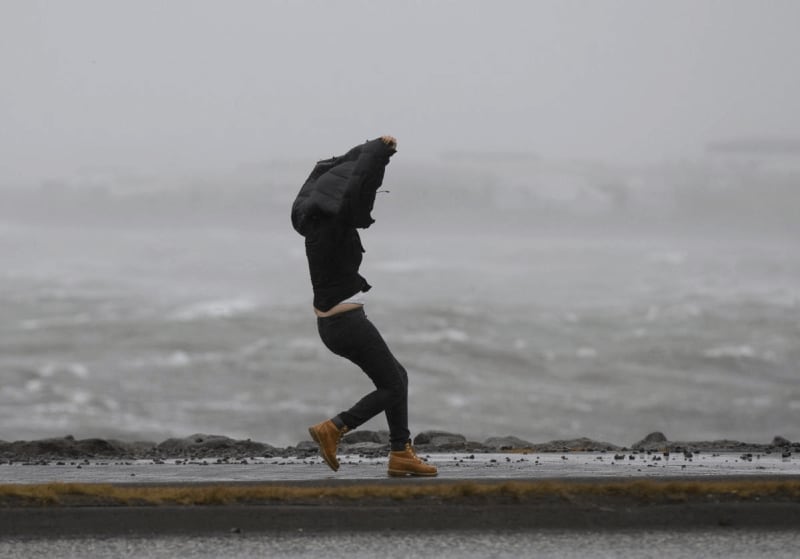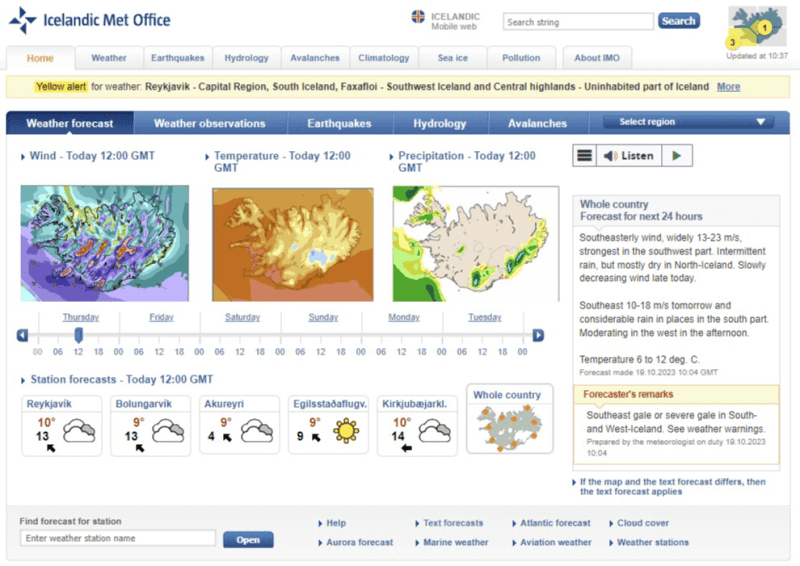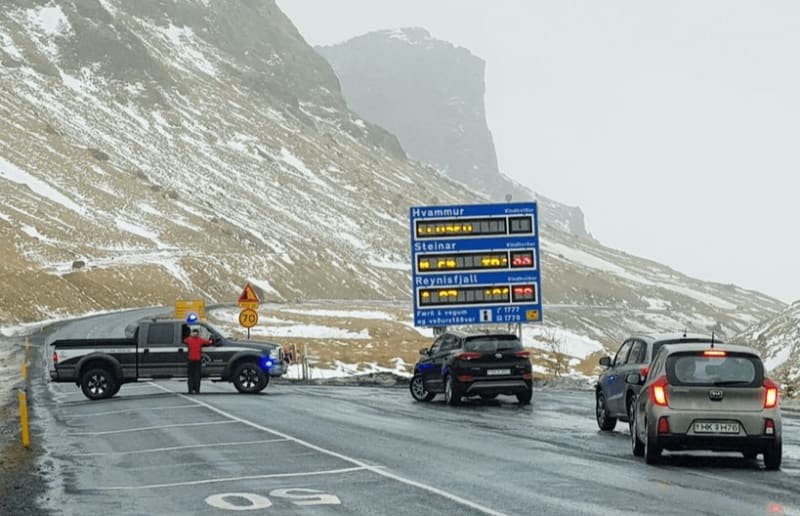Understanding the Wind Forecast
When traveling in Iceland, the wind can be as much of a factor as the temperature or precipitation. It's not just about how strong the wind is, but also its direction, consistency, and potential for gusts. Here's how to decipher the wind forecast and make informed decisions:
Also check out our blog: Weather in Iceland | Everything You Need to Know
1. Sources for Wind Forecasts
- Vedur.is: The official website of the Icelandic Meteorological Office. It provides real-time updates on wind conditions, temperature, and other weather parameters. It's the go-to source for many locals.
- Belgingur.is: Another reliable source for weather predictions in Iceland, including detailed wind maps.
- SafeTravel.is: SafeTravel is run by ICE-SAR — The Icelandic Association for Search and Rescue. There you can download the app as well as write travel plans for safety and more.
2. Reading Wind Speed and Direction
Understanding the nuances of wind speed and direction is crucial when navigating Iceland's diverse landscapes. Here's a deeper dive into how to interpret these factors:
Wind Speed
-
Measurement: In Iceland, wind speed is typically measured in meters per second (m/s). This might be different from what you're used to, especially if you come from a country that uses kilometers or miles per hour.
-
Reference Points:
- 1-5 m/s: A light breeze. You'll feel the wind on your face, but it won't significantly impact your activities.
- 6-10 m/s: Moderate wind. You might start to hear the wind whistling and feel its push while walking.
- 11-17 m/s: Strong wind. It can make driving challenging, especially for high-profile vehicles like campers or vans.
- Above 18 m/s: Very strong to stormy conditions. It's advised to avoid driving, especially in open areas where the vehicle can be more affected.
Wind Direction
-
Understanding Origin: Wind direction is described based on where it's coming from. For instance, a north wind originates from the north and blows towards the south.
-
Impact on Temperature: The wind direction can influence the perceived temperature. In Iceland, a wind coming from the north might be colder than a wind from the south. This is essential to consider when dressing for the day.
-
Local Effects: Wind direction can also determine which parts of the country receive more precipitation. For example, if the wind is coming from the sea, coastal areas might experience rain, while inland areas remain dry.
Tools to Visualize Wind
-
Wind Maps: These are graphical representations of wind conditions. Arrows indicate the direction, while color or arrow size represents speed. Websites like Vedur.is often provide these maps, giving travelers a visual sense of the day's conditions.
-
Wind Rose Diagrams: These are circular charts that show how wind speed and direction are typically distributed at a particular location. It's a useful tool if you're looking for patterns or trying to understand the prevailing winds in an area.
By grasping the intricacies of wind speed and direction, you'll be better equipped to plan your journey, ensuring safety and comfort.

3. Understanding Gusts
Gusts can be thought of as the wild cards of the wind world. They're sudden, short-lived increases in wind speed, often catching travelers off guard. Let's delve into the nature of gusts and why they're especially important to be aware of in Iceland.
What are Gusts?
-
Definition: A gust is a brief increase in wind speed, typically lasting just a few seconds. It's a sudden burst of wind that's notably stronger than the average wind speed around it.
-
Causes: Gusts can be caused by various factors, including the passage of weather fronts, the presence of storms, or even the landscape's topography, such as when wind rushes down a mountain slope.
Why Gusts Matter in Iceland
-
Unpredictability: Due to their sudden nature, gusts can surprise drivers, especially those in high-profile vehicles like campers, SUVs, or vans. A strong gust can push a vehicle off its course, posing a risk, especially on narrow roads or near cliffs.
-
Temperature Drops: Gusts, especially those accompanying cold fronts, can bring a sudden drop in temperature. This can lead to rapid weather changes, including the onset of rain or snow.
-
Impact on Activities: For those planning outdoor activities like hiking or sightseeing, gusts can make conditions more challenging. It's harder to walk against a gusty wind, and the wind chill can make it feel much colder than the actual temperature.
For preventing pain points and exploring Iceland, click here
Tips for Handling Gusts
-
Stay Informed: Before heading out, check the weather forecast for any gust warnings. Websites like Vedur.is provide detailed wind forecasts, including potential gust strengths.
-
Driving with Caution: If you're driving and encounter gusts, reduce your speed, grip the steering wheel firmly, and be prepared for sudden changes in direction. If the gusts become too strong, consider pulling over safely and waiting them out.
-
Secure Your Belongings: If you're camping or picnicking, ensure that all your belongings, especially lightweight items, are securely anchored. A gust can easily send tents, hats, or even picnic blankets flying!
Understanding gusts and their potential impact is essential for anyone traveling in Iceland. By staying informed and taking precautions, you can ensure a safer and more enjoyable trip.

4. Topography's Impact on Wind
Iceland's diverse landscape, with its mountains, valleys, and coastal areas, plays a significant role in influencing wind patterns. Understanding how topography affects wind can help travelers anticipate and navigate windy conditions more effectively.
How Topography Influences Wind
-
Mountain Winds: As wind approaches a mountain, it's forced upwards. Once it reaches the mountain's peak, it can accelerate rapidly as it descends down the other side. This phenomenon, known as the "mountain wave," can lead to strong, gusty conditions on the leeward side of the mountain.
-
Valley Winds: Valleys can channel wind, making it flow faster, much like water in a river. During the day, valley winds typically flow uphill, while at night, cooler air descends, causing winds to flow downhill.
-
Coastal Effects: Coastal areas in Iceland can experience strong winds due to temperature differences between the land and sea. Sea breezes, which blow from the sea towards the land, are common during the day, while land breezes, blowing from the land to the sea, occur at night.
Check out rental guide to Icelandic highlands
Why It Matters for Travelers
-
Variable Conditions: The same day can see calm conditions in a coastal town, gusty winds in a mountain pass, and a steady breeze in a valley. Being aware of how topography affects wind helps travelers anticipate changes as they move from one region to another.
-
Planning Activities: If you're considering hiking, camping, or other outdoor activities, understanding the local topography can help you choose locations with more favorable wind conditions.
-
Road Safety: Certain roads, especially those that traverse mountain passes or run along coastlines, can be particularly windy. Knowing what to expect can help drivers prepare for challenging conditions.
Tips for Navigating Topographical Wind Effects
-
Stay Updated: Use local weather resources, like Vedur.is, to get wind forecasts specific to different regions of Iceland. These forecasts often provide insights into expected wind patterns based on topography.
-
Seek Local Advice: Locals often have a deep understanding of how wind behaves in their region. If you're unsure about conditions, ask residents or local businesses for advice.
-
Adjust Plans: If you know a particular area is prone to strong winds due to its topography, consider adjusting your plans or timing to ensure safer travels.
By recognizing the role of topography in shaping wind patterns, travelers can make more informed decisions, ensuring a safer and more enjoyable Icelandic adventure.
5. Color-Coded Warnings
When traveling in Iceland, it's essential to be aware of the color-coded wind warnings issued by meteorological agencies. These color codes provide a quick and visual way to understand the severity of the wind conditions, helping travelers make informed decisions.
Understanding the Colors
Typical wind conditions, no significant warnings. It's generally safe for all regular activities and travel.
Wind speeds are increasing. Travelers should be cautious, especially if planning outdoor activities or driving in exposed areas.
Strong winds expected. It's advisable to reconsider travel plans, especially in high-profile vehicles. Outdoor activities in exposed areas might be risky.
Severe wind conditions are imminent or occurring. It's recommended to avoid all unnecessary travel. Seek shelter and stay informed about the latest updates.
Why It Matters for Travelers
-
Quick Assessment: The color codes offer a rapid way to gauge the wind situation, especially useful when you're on the move.
-
Safety First: By adhering to these warnings, travelers can ensure their safety and avoid potentially dangerous situations.
-
Planning Ahead: Knowing the expected wind conditions can help travelers adjust their itinerary, ensuring they don't get caught in adverse conditions.
Tips for Staying Updated
-
Bookmark Reliable Sources: Websites like Vedur.is provide real-time updates and color-coded warnings for different regions in Iceland.
-
Mobile Alerts: Consider downloading weather apps that offer notifications for severe weather conditions, ensuring you're always in the loop. Download the SafeTravel App.
-
Local Advice: In addition to online resources, locals and accommodation providers often have up-to-date information on current conditions. Don't hesitate to ask!
By understanding and respecting the color-coded wind warnings, travelers can ensure a safe and enjoyable journey, regardless of Iceland's unpredictable weather.
6. Plan According to the Forecast
When venturing into Iceland's diverse landscapes, it's crucial to align your plans with the wind forecast. The weather in Iceland can change rapidly, and being prepared can make the difference between a memorable trip and a challenging one.
Check the Forecast Regularly
-
Morning Ritual: Make it a habit to check the wind forecast every morning before setting out. Websites like Vedur.is provide detailed forecasts for the entire country.
-
Stay Updated on the Go: There are several mobile apps available that provide real-time weather updates. Having one on your phone can be a lifesaver.
Adjust Your Itinerary
-
Flexible Plans: If strong winds are predicted for a particular region, consider altering your route or schedule. Maybe there's a museum, hot spring, or indoor attraction you've been meaning to visit?
-
Seek Sheltered Areas: Some parts of Iceland offer natural windbreaks. If you're camping or hiking, look for valleys, gorges, or forests that can provide some protection from the wind.
Driving Considerations
-
High-Profile Vehicles: If you're renting a camper or an SUV, be extra cautious. These vehicles can be more susceptible to strong winds, especially on open roads.
-
Bridge Crossings: Wind speeds can be particularly high on bridges. Slow down and grip the steering wheel firmly.
-
Parking: When parking, especially overnight, try to find a spot that's shielded from the wind. This not only ensures safety but can also provide a more comfortable rest.

Communicate Your Plans
-
Share Your Itinerary: Let someone know where you're headed, especially if you're venturing into remote areas. This can be a hotel staff member, a local friend, or even an online travel group. You can use the SafeTravel travel plans for individuals, groups and tours.
-
Stay Connected: Ensure your phone is charged and consider investing in a local SIM card or a portable Wi-Fi device. In case of any changes or emergencies, it's vital to stay connected.
By planning according to the forecast, you not only ensure your safety but also maximize your chances of having an enjoyable and uninterrupted journey through Iceland's stunning landscapes.
Driving Safely in Windy Conditions
Driving in strong winds can be challenging, especially in a country like Iceland where the terrain varies and open roads can expose vehicles to intense gusts. Here are some essential tips to ensure you navigate the roads safely during windy conditions.
1. Understand Your Vehicle
-
Vehicle Profile: Remember, the higher the vehicle's profile (like campers or SUVs), the more it's affected by wind. If you're renting, ask the rental agency for advice specific to the model you're driving.
-
Weight Matters: Lighter vehicles can be more susceptible to wind. If you're in a camper, it might help to have water tanks full to add some weight.
Check out this guide about car rental tips, pick-up, driving and returns
2. Adjust Your Speed
-
Reduce Speed: It's crucial to drive slower than usual in windy conditions. High speeds can make it harder to control the vehicle if a strong gust hits.
-
Avoid Sudden Accelerations: Rapid acceleration can make the vehicle unstable, especially in crosswinds.
3. Firm Grip on the Steering Wheel
-
Two Hands: Always keep both hands on the steering wheel, especially on open roads or bridges where gusts can be stronger.
-
Anticipate Gusts: Be ready for sudden gusts, especially when passing larger vehicles or when approaching gaps in roadside trees or buildings.
4. Increase Following Distance
- Stay Back: Give yourself more space than usual behind the vehicle in front of you. This gives you more time to react if they face difficulties.
5. Be Cautious of Surroundings
-
Watch for Debris: Strong winds can blow debris onto the road. Be vigilant and ready to avoid any obstacles.
-
Beware of Water: Wind can push water onto roads, creating slippery conditions. If you see water ahead, slow down and approach with caution.
6. Take Breaks
-
Rest Your Hands and Mind: Driving in windy conditions can be tiring. Take regular breaks to rest and stay alert.
-
Check the Forecast: During your breaks, check the latest wind forecast and adjust your plans if necessary.
7. Know When to Stop
- Safety First: If the wind becomes too strong and you feel unsafe, it's essential to find a safe place to pull over and wait it out. It's better to delay your journey than risk an accident.
Prioritize Safety
When traveling in Iceland, especially in challenging weather conditions, safety should always be your top priority. Here's how to ensure you and your fellow travelers remain safe during your journey.
1. Stay Informed
-
Regularly Check Weather Updates: Use reliable Icelandic weather websites or apps to stay updated on current and forecasted conditions.
-
Listen to Local Advice: Locals and rental agencies often have the best insights on current road conditions and potential hazards.
2. Equip Your Vehicle
-
Winter Tires: If traveling during the colder months, ensure your vehicle has winter tires fitted.
-
Emergency Kit: Always have an emergency kit in your vehicle. This should include items like a flashlight, blankets, water, non-perishable food, and a first-aid kit.
3. Know Your Limits
-
Avoid Night Driving: In the winter, Iceland has limited daylight hours. Plan your travels during daylight to avoid additional risks.
-
Don't Push Through: If you're feeling tired or the weather is deteriorating, find a safe place to rest or stay overnight.
4. Respect Road Closures
-
Heed Warnings: If a road is closed, it's for a good reason. Never attempt to bypass roadblocks or drive on closed roads.
-
Plan Alternative Routes: Always have a backup plan in case your primary route is inaccessible.
5. Stay Connected
-
Inform Someone: Let someone know about your travel plans and expected return, especially if traveling to more remote areas.
-
Stay Charged: Ensure your phone is fully charged, and consider carrying a portable charger. In case of emergencies, the ability to call for help is crucial.
6. Avoid Risky Areas
-
Stay Away from the Shore: In windy conditions, waves can be unpredictable. Maintain a safe distance from the shoreline to avoid being swept away.
-
Beware of Ice: In colder months, areas near waterfalls or shaded spots can be icy. Tread carefully and consider wearing ice grips on your shoes.
For information about Icelandic traffic laws and more, click here
Remember, no destination or schedule is worth compromising your safety. Always prioritize your well-being and that of your fellow travelers. When in doubt, wait it out or seek local advice
By understanding the wind forecast, you're not only ensuring your safety but also maximizing your enjoyment of Iceland's breathtaking landscapes.




